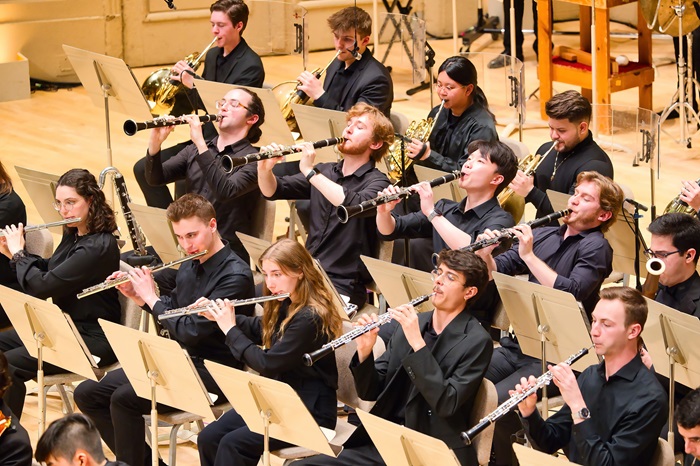Zander and BPYO try out program of romantic masters before European tour

Benjamin Zander conducted the Boston Philharmonic Youth Ochestra and cellist Zlatomir Fung in Schumann’s Cello Concerto Friday night. Photo: Hilary Scott
The Boston Philharmonic Youth Orchestra and Benjamin Zander delivered a remarkable performance at Symphony Hall on Friday night to cap off their 12th season. The program of Schumann and Mahler, which the orchestra takes on their European tour this coming June, was a superbly performed showcase of the complexities of 19th-century romanticism.
Schumann’s Cello Concerto and Mahler’s Fifth Symphony came from opposite ends of the romantic period. Though separated in composition by fifty years, the two pieces chart substantial cultural shifts in musical style even as the romantic aesthetic—the centrality of the artist, nature, and lyric freedom over formal constraint—remained constant.
When compared to classical formalism, the easy romanticism of the Schumann concerto, with its free-flowing melodies and gentle accompaniment, seems an enormous departure even from Beethoven; however, when compared to Mahler’s formal inversions, irony, and enormity, Schumann seems almost classical in his lightness and play.
Cellist Zlatomir Fung returned to the BPYO as soloist in this performance. Fung offered a sprightly and tender rendering of the concerto, with his flexible and pleasant tone modulating easily through the work’s many moods. The opening chords of the first movement, followed by an expressive entrance by Fung, immediately centered the sensitive relationship between the soloist and the orchestra. The excellent balance between the two continued throughout, with the orchestra maintaining a support that made the delicacy and dynamic range in Fung’s interpretation evident in every phrase.
The second and third movements allowed Fung to showcase a range of styles, from the simple lyricism of the Langsam, with its folk influences, to the technical skill of the third movement. Fung’s final cadenza finished the piece with a perfect combination of precision and virtuosity.
Fung responded to audience enthusiasm with an encore of Ernest Bloch’s “Prayer,” the first piece in From Jewish Life, a moving performance that shifted the tone of the program towards the Jewish melodies so prominently featured in Mahler’s work.
As Zander reminded the audience, Mahler’s Fifth Symphony is a project in and of itself. As the romantic movement progressed, orchestras became larger (there were 120 musicians on stage for the Mahler) and the demands of the symphony more strenuous. As Zander said, “Mahler believed a symphony should contain the whole world.” In spite of the challenge posed by Mahler, the orchestra gave the audience no reason to remember its youth. The performance from both ensemble and section soloists was powerful from the opening of the first movement to the spectacular final triumph of the fifth movement.
From the opening trumpet solo of the first movement, delivered by Reynolds Martin, the fantastic sound and blend of the brass was a theme of the evening. The contrasting restraint of the strings made for a tense atmosphere, which finally broke into a thrilling dance. In the second movement, the orchestra moved easily between Mahler’s irony and pathos. The cellos, who were intrepid throughout, opened the movement with a menacing entrance, followed by somber melodies in the strings. Timpanist Ritvik Yaparpalvi ushered the movement into a stunning but brief moment of triumph featuring the brass that made the hall ring.
The third movement (Scherzo) that bridges the two halves of the Fifth Symphony relies on the horn, and principal Graham Lovely led the horns gallantly in this movement, with wonderful tone and confidence. If the orchestra was uncertain anywhere, it was in this most difficult movement, but any sense of instability was quickly resolved by strong section leadership and communication from the podium.
After three movements of intensity, the fourth movement (Adagietto), perhaps Mahler’s most famous movement, called upon the strings for a different set of skills. A love letter to Alma Mahler, the composer’s future wife, this tender and sincere piece requires passion, sensitivity, and deep earnestness. The strings sounded tender and soulful, with the interventions of harpist Shaylen Joos adding luminous details that created a simultaneous sense of repose and hope.
The concert ended in the Rondo-Finale, which in its spirited irony recalled the lightness of the Schumann and seemed to put a period at the end of the performance. This movement recalls Mahler’s first and third symphonies more than the other four, especially in the winds whose performance was strong throughout. The concert closed with a perfectly tuned and ecstatic chord from the brass, subsuming this piece’s despair and uncertainty into robust merriment—a joyful conclusion to the season.
Posted in Performances
